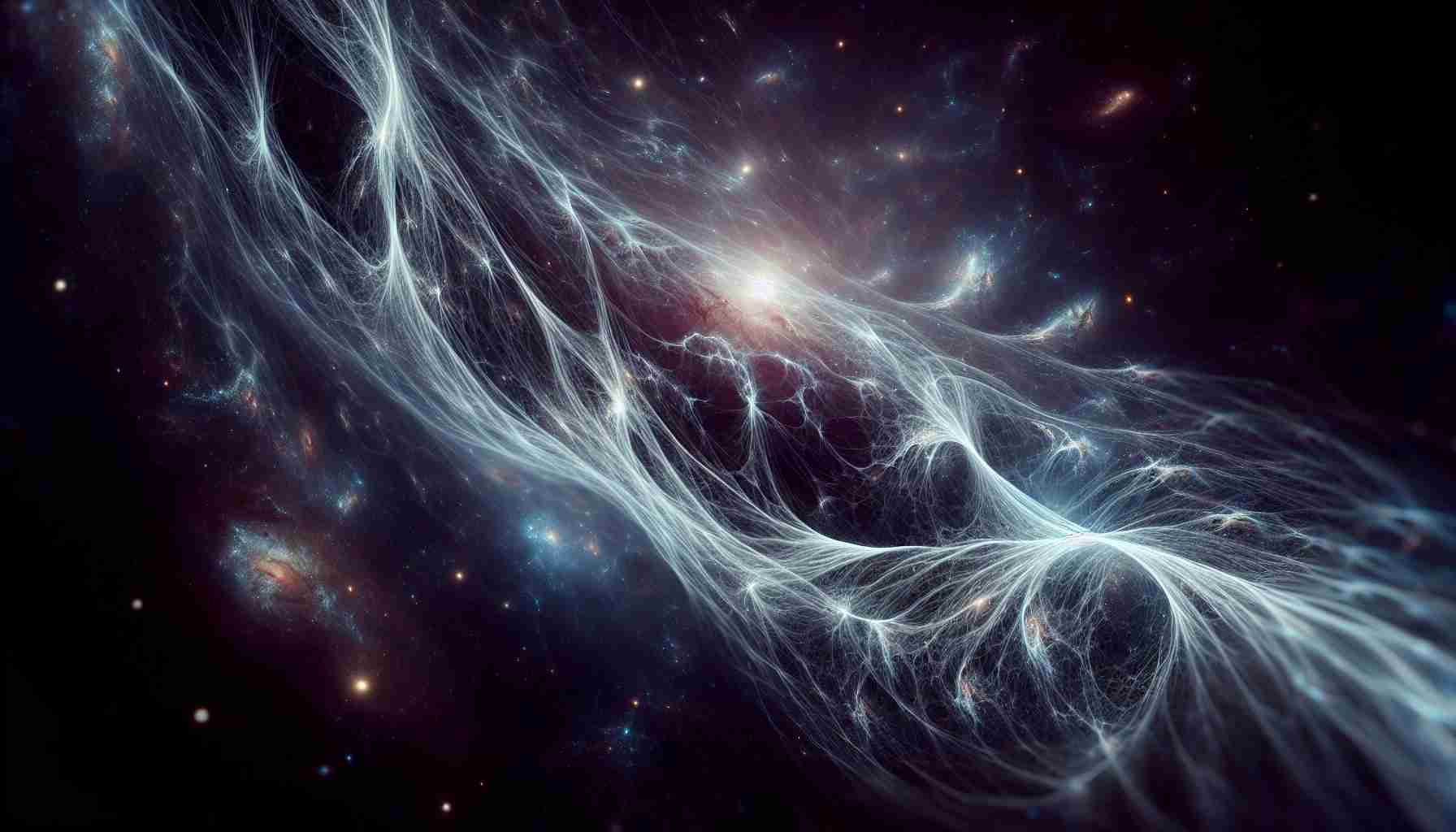- Scientists have captured a vivid image of a cosmic filament, a massive galactic structure connecting two galaxies over 3 million light-years.
- The image was obtained using the MUSE spectrograph on the Very Large Telescope in Chile, highlighting a dynamic space with new stars and black holes.
- Cosmic filaments, influenced by dark matter, form the universe’s structure, where galaxies cluster and stars are born.
- Led by Davide Tornotti, the research team overcame challenges to capture this elusive filament’s precise imagery for the first time.
- The discovery aligns observed and predicted cosmic structures, enhancing our understanding of the universe’s architecture.
- Each cosmic discovery contributes to unveiling the universe’s hidden forces and structures.
Unveiling a secret hidden since the dawn of the cosmos, scientists have captured the most vivid image yet of a cosmic filament—a massive, galactic highway connecting two distant galaxies. Snaking through the universe over 3 million light-years, these filaments form the invisible backbone of reality, weaving a web where stars are born and galaxies collide.
Observed by a team of international researchers using the powerful MUSE spectrograph on the Very Large Telescope in Chile, this image showcases a dynamic bridge amid galaxies bursting with fiery new stars and voracious black holes. The filament, stretching across this vast distance, glows faintly, a testament to the delicate dance of particles that sway to the pull of gravity.
Astrophysicists believe dark matter—a mysterious substance constituting 85% of the universe’s mass—crucially sculpts these cosmic webs. Under its invisible hand, galaxies cluster at filament intersections, drawing in rivers of gas that birth stars in brilliant ebbs and flows.
Yet, capturing this elusive dance has baffled astronomers for eons. The team, led by Davide Tornotti, a PhD student at the University of Milano-Bicocca, defied these odds. They braved hundreds of observation hours, unveiling the filament’s arcane beauty for the first time. Such precise imagery blurs the boundary between theory and observable truth, tracing gas flow with unprecedented clarity.
This discovery marks not just a singular achievement but opens vistas for future exploration. Syncing images with supercomputer simulations, researchers found remarkable harmony between predicted and observed cosmic structures. As we peer deeper into the cosmic web, each discovery brings us closer to understanding the universe’s hidden architecture and the elemental forces that bind it. With each faint glow, another thread of our celestial tapestry is illuminated.
Unlocking the Mysteries of Cosmic Filaments: How They Shape Our Universe
How-To Steps & Life Hacks
Understanding Cosmic Filaments:
1. Background Knowledge: Study the basics of cosmology and astrophysics to grasp fundamental concepts like dark matter and the large-scale structure of the universe.
2. Telescope Access: Access or collaborate with research teams working with telescopes like the Very Large Telescope in Chile to observe cosmic phenomena.
3. Data Analysis: Learn data analysis techniques used in astrophysics to interpret spectrographic data from observations.
4. Simulations: Use supercomputer simulations to model cosmic structures and compare with observational data.
Real-World Use Cases
Cosmic Filaments in Research:
– Galaxy Formation: Understanding the role of cosmic filaments in channeling matter helps explain the formation and evolution of galaxies.
– Dark Matter: Provides indirect evidence and insights into the distribution and behavior of dark matter in the universe.
Market Forecasts & Industry Trends
Astrophysical Tools & Tech:
– Growing Investment: Expect increased funding in technologies enhancing spectrographic imaging and data analysis due to their crucial role in uncovering cosmic mysteries.
– Emerging Software Solutions: Enhanced simulation software will see increased development to support astrophysical research.
Reviews & Comparisons
Telescope Technologies:
– Very Large Telescope (VLT): Highly powerful in its class, offering precise spectroscopic capabilities.
– Hubble Space Telescope: A different type of observational tool with strengths in different wavelengths and imaging broader fields of view.
Controversies & Limitations
Observational Challenges:
– Cosmic filaments are faint and require immense observation time to detect, posing significant challenges.
– Reliance on indirect detection methods due to limitations in current technology, sparking debates on interpretation accuracy.
Security & Sustainability
Observational Sites:
– Environmental Impact: Observatories like those in Chile must consider their ecological footprint and work towards sustainable practices.
– Data Security: Safeguarding vast amounts of sensitive research data is critical in collaborative international projects.
Insights & Predictions
– Astrophysical Progress: As technology advances, we will likely refine our understanding of cosmic structures, potentially linking them to phenomena like dark energy.
– Interdisciplinary Cross-Fertilization: Increased collaboration between fields such as physics, artificial intelligence, and astronomy will yield innovative research methodologies.
Pros & Cons Overview
Cosmic Filament Research:
– Pros: Offers profound insights into the universe’s structure and dark matter, guides theories on galaxy formation.
– Cons: Resource-intensive, requires advanced technological infrastructure, and often relies on indirect evidence.
Actionable Recommendations
– Stay Informed: Follow cutting-edge research publications and updates from organizations like the European Southern Observatory.
– Engage in Citizen Science: Participate in projects like Galaxy Zoo, contributing to the classification and study of astronomical data.
– Continuous Learning: Enroll in online courses and workshops to keep abreast of advances in astrophysics and unite theoretical knowledge with practical skills.
For further exploration, visit the official sites of leading research institutions such as the European Southern Observatory and the NASA.
